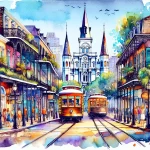Louis Armstrong Park, a verdant 32-acre retreat situated within New Orleans’ historic Treme neighborhood, stands as a captivating celebration of the city’s profound musical legacy, beckoning visitors to immerse themselves in the soulful rhythms that define the essence of New Orleans music.
In This Article
TL;DR
- This park honors the iconic Louis Armstrong and other musical pioneers from New Orleans.
- It encompasses Congo Square, a hallowed site where enslaved Africans gathered to express their musical and dance traditions, shaping numerous African-American genres.
- Visitors can explore sculptures, theaters, and attend live performances that showcase the city’s diverse musical tapestry.
History and Cultural Significance
Louis Armstrong Park resides within the Treme neighborhood, one of the oldest African-American communities in the United States. The area’s rich history dates back to the early 19th century, when it was a vibrant center for free people of color. The park’s location is particularly notable due to the presence of Congo Square, a revered site that played a pivotal role in the evolution of African-American music and culture in New Orleans.
Congo Square
At the heart of Louis Armstrong Park lies Congo Square, a hallowed site that has been integral to the development of African-American music and dance traditions in New Orleans. In the 18th and 19th centuries, enslaved Africans would gather in Congo Square on Sundays, their sole day off, to socialize, trade goods, and engage in musical and dance performances. These gatherings provided a rare opportunity for enslaved people to express themselves freely and preserve their cultural traditions in the face of oppression.
The music and dance styles that flourished in Congo Square profoundly influenced the development of African-American musical genres, particularly jazz. Today, Congo Square continues to serve as a performance space and cultural landmark, hosting various events and festivals throughout the year that celebrate the rich musical heritage of New Orleans.
Mahalia Jackson Theater
Situated within Louis Armstrong Park, the Mahalia Jackson Theater is a state-of-the-art performing arts venue that hosts a variety of musical and theatrical productions. The theater is named after Mahalia Jackson, a renowned gospel singer born in New Orleans who became one of the most influential figures in the genre.
Sculptures and Monuments
Throughout Louis Armstrong Park, visitors will encounter a variety of sculptures and monuments that pay homage to the city’s musical icons. The most prominent of these is the Louis Armstrong statue, a larger-than-life bronze sculpture created by artist Elizabeth Catlett. Other notable sculptures in the park include the Sidney Bechet statue and the Buddy Bolden monument.
Musical Performances and Events
Louis Armstrong Park is not only a place to learn about the history of New Orleans music but also a vibrant venue for live performances and cultural events. Throughout the year, the park hosts a variety of festivals and concerts that showcase the city’s diverse musical traditions, from jazz and blues to hip-hop and bounce.
One of the most popular events held in the park is Jazz in the Park, a free concert series that features local jazz artists. Another notable event is the Congo Square Rhythms Festival, an annual celebration of African diaspora music and culture.
Outdoor Recreation and Amenities
In addition to its musical and cultural offerings, Louis Armstrong Park provides a beautiful and tranquil setting for outdoor recreation and relaxation. The park features well-maintained walking paths, landscaped gardens, scenic lagoons, benches, and picnic areas.
Visiting Louis Armstrong Park
Louis Armstrong Park is located at 701 N. Rampart Street, just a short walk from the French Quarter. The park is open daily from 8:00 AM to 6:00 PM, and admission is free. When planning a visit, it’s a good idea to check the park’s event calendar for special performances or festivals.
To make the most of your visit, wear comfortable walking shoes, bring water and snacks, and be prepared to experience the rich history, vibrant culture, and beautiful setting that make Louis Armstrong Park a true highlight of New Orleans.






